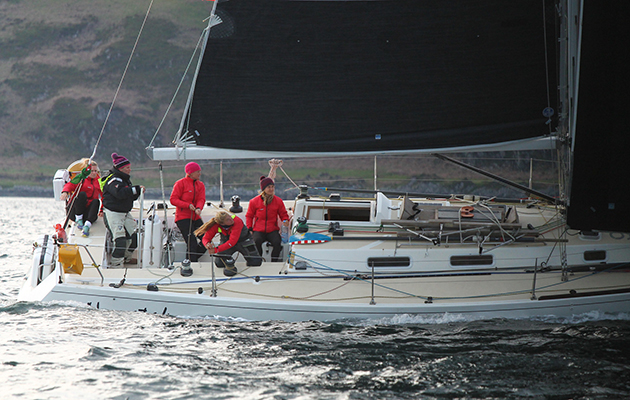Another frustrating, exhausting, but exhilarating sail to Fort William brings Pip Hare's sailing team in 1st – now it's all down to the runners heading up Ben Nevis
At 1049 on Wednesday morning Jo and Lowri ran over the finish line and straight into the arms of our sailing team and the history books of the Three Peaks Yacht Race.
We have won, line honours, overall sailing on handicap, leg 3 sailing and running combined and would end up 2nd overall on sailing and running combined. We are only the fourth ever female team to finish the race and the first to win. The final leg from Whitehaven had allowed us to shine, but was not without its drama and soul-destroying moments.
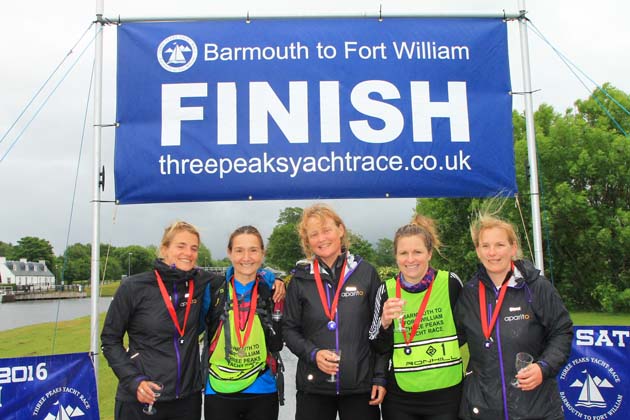
During Monday afternoon our runners, Jo and Lowri, battled their way around the biking and running course from Whitehaven, to the top of Scafell Pike and back while we the sailors slept – read our nail-biting story of Leg 2 here – organised and fretted back on Nunatak in Whitehaven marina. We had positioned the boat in a prime berth, right opposite the marina entrance where the lock gates were on free flow, and waited for their return with nervous anticipation.
The girls appeared at the top of the ramp, covered in bruises and blood from multiple tumbles while running on the slippery paths of the Lake District’s highest peak, our shore crew waited on the corner of the pontoon to direct them, the film crews set up to capture their return, and Elin shouted to a group of sailors to clear the way. All eyes were on the runners for a dramatic entrance.
Slipping and sliding
Lowri led the way, the cameras were rolling, she came down the ramp onto the main pontoon and tried to turn the corner up to the boat, but her cycling shoes with cleats on the bottom and no grip gave way and she promptly slid over in a heap on the floor.
Jo, not far behind, saw what happened and tried to avoid the same spot, but left it too late and wiped out on the same corner, leaving both of them in a pile – a very helpful gentleman watching proceedings from his cockpit, sniffed and loudly conjectured: “And that’s why we don’t run on the pontoons!” Such helpful comments.
With the runners safely on board, egos intact, we headed straight out through the open lock gates. We were in 4th position, with a distance of six miles between us and the lead boat, Wight Rose, to catch up the front of the fleet.
The evening was murky and started with light winds. We were chasing the other boats, but with little opportunity to make gains. After a couple of hours the wind started to change direction and soon we were reaching for our spinnaker and Nunatak started racing towards the Mull of Galloway.
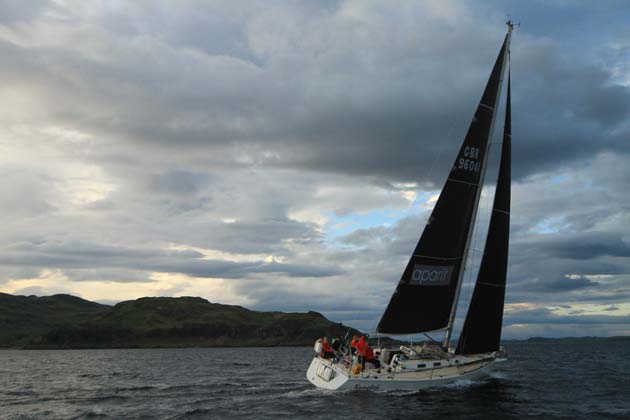
Down below the runners were tucked into their bunks, kick starting their recovery from the previous 9.5 hours of effort, and as the speed built they were woken up by the sound of water rushing down Nunatak’s hull, and the occasional squawk of delight from the helm as we started clocking speeds of over 13 knots over the ground.
We approached the Mull of Galloway under spinnaker and with the three of us trimming the boat as hard as we could, Nikki on the helm, Elin managing the pole and me trimming and navigating. By now we could see the outline of Pure Attitude and knew they did not have their spinnaker up. We were gaining on them fast and decided to pass between them and the shore, right under the cliffs of the Mull.
Overhauling the lead boat
The cockpit was alive with tension as we scraped our way along the shore to keep out of the tide. The wind was blowing down through the gaps in the cliffs, heeling the boat over suddenly and rounding us up, requiring great team work from the three of us to keep moving and to keep safe.
We worked intensely for three or four hours, constantly talking to each other about course, trim, speed – focused, determined and loving the opportunity to sail hard together.
The strategy paid off and by the time the sun came up on Tuesday morning we were leading the fleet. Wight Rose and Moby J were over six miles behind us and Pure Attitude could be seen on the horizon. But as is the way with sailing among the hills in the Scottish Highlands, not long after the sun came up we sailed into a massive windless hole and sat there helplessly while Pure Attitude sailed up behind us.

Pure Attitude
Our rowing seats and outriggers had been taken apart and stowed for the spinnaker leg and getting them out of the locker and in position seemed to take for ever – it was stressful as all the while our competitors were effortlessly sailing up to us. I fumbled with the screws and bolts, put the struts on in the wrong order and couldn’t get them off again.
I wanted to swear, but the onboard camera woman was filming my frustration – these things seem so cruel, after putting in such a lot of effort to get ahead.
The next couple of hours were spent rowing between wind holes. We adopted the mantra ‘just keep the boat moving’ in recognition of the fact that we could row Nunatak at a reasonable 1.5 knots once she had momentum, but trying to get any speed from a standing start was very hard.
Rowing, rowing, rowing …
The three sailors rotated round, taking it in turns to row on each side and to steer. The sails stayed set and we rowed to where we could see wind on the water. When we started to sail we shipped the oars, but stayed in position and as soon as the speed dropped below 2 knots we would start rowing again.
I was starting to develop blisters on my palms from the rough wooden oar handles, Nikki and Elin’s backs were hurting, but we rowed on determined to keep our lead. The runners woke up with the commotion on deck and came up to offer help – we were still pretty adamant we did not want them to jeopardise their recovery by rowing a lot, but Jo helmed and Lowri did a couple of stints rowing so we could eat and drink or strip off a few layers.
Eventually our diligence paid off. We rowed to a solid breeze and ghosted away, watching our rivals lolling behind. The experience had been unnerving so we left the rowing seats on deck, but the wind built enough for a quick ride past the Mull of Kintyre and into the Sound of Jura.
 Following another few hours of playing cat and mouse with the wind, always terrified we would park up in a hole while our rivals slid past in wind not far away – we had at one stage hoisted Nikki up the mast to survey the route ahead looking for calm patches on the water – we finally found a solid breeze and started moving again up the sound.
Following another few hours of playing cat and mouse with the wind, always terrified we would park up in a hole while our rivals slid past in wind not far away – we had at one stage hoisted Nikki up the mast to survey the route ahead looking for calm patches on the water – we finally found a solid breeze and started moving again up the sound.
By this time the tide was against us and so we needed to hug the edges of the loch to get out of the tide and make better progress. By now it was a sunny day and the runners – who had been nicknamed ‘The meercats’ as they stuck their heads out of the hatch to look around before going back to their bunks to continue recovery – came out on deck and we worked Nunatak up the Jura shore.
Again we sailed like a fully crewed boat, tacking in and out of a 100m band from the shore, sometimes coming within a few metres of the rocks before tacking out, then heading back in as soon as we saw a drop in our speed over the ground.
We tacked around 100 times over that afternoon and evening. Our course on the tracker looks like a smooth line heading exactly north and gives no indication to the amount of effort expended to achieve it.
Tack by tack
It is hard not to give a blow by blow account of the following 12 hours. I can remember pretty much every tack – we worked our way between rocks and islands, the wind increased to create fairly rough conditions at the beginning of the night and for the first time in the race we had waves crashing over the deck.
We had managed to work our way ahead of Pure Attitude, but did not stop trying to gain every knot of speed we could to increase our lead and give our runners a great head start. They lay down below in their bunks, listening to us working, starting to feel the tension as we drew closer and closer to Fort William – soon it would be their turn.
We came through the Corin narrows with a two-hour lead; the cloud cleared from the top of Ben Nevis and we could see the steep ascent speckled with patches of snow. It looked formidable – neither of the runners could eat as they prepared for their last summit. Meanwhile on deck we fought for every second of advantage we could gain.
With only a couple of miles to go and in flatter water we had one further drama to navigate, which could still cost us significant time between the finish and dropping the runners. During the night while charging the engine had stopped. We had very little fuel and were heeled over and managed to suck air into the fuel system.

Teams rowing
Halfway up the channel we decided to try to bleed the engine and do a test start in neutral to see if we could get it going again. If that did not work we would need to pump up the tender and row the runners ashore, which would take a lot of preparation.
While Elin and Nikki tacked their way up the shallows off Fort William I had my head inside the engine bay, trying to brace myself against the heel of the boat and frantically working the fuel lift pump. It took a couple of goes, but we managed to bleed all the air out of the engine. We hit the finish line then raced towards the dock at the entrance to the Caledonian Canal.
Chris, our shore crew ,was waiting on the dock to catch our lines. We came in with speed and our runners jumped off, all of us feeling sick with nerves. We had smashed it – the sailing leg was won and the coveted line honours trophy, which has been the goal of many a great sailor and adventurer since 1977, was within our grasp.
Up the mountain
Jo and Lowri set off up the mountain in worsening conditions. It was cold and raining, the wind was building, we could no longer see the summit and the cloud was hanging low everywhere. We were elated to have finished the sailing in 1st, but feeling agitated and powerless to do anything further as it was all down to our runners. So once we had secured Nunatak inside the lock we all jumped in a couple of cars to go and wait on the Ben Nevis foothills.

It was raining and cold on the mountain – there were camera crews dotted up the track waiting for the girls to come past. We split up, some of us climbing up the path, some waiting further down and as soon as the yellow bibs of our runners came into sight we started to cheer. They looked great, smiling and confident; they had seen the crew of Pure Attitude coming up as they were coming down and were happy they had a good lead. We ran with them down the final section, chatting and laughing and telling them how amazing we thought they were.
Our second shore support, Mike, who was the previous owner of Nunatak and has competed in the Three Peaks Race multiple times was with us and said the last few miles from the foothills back to the lock are tough and soul-destroying. They are on roads, through industrial and housing estates, a lonely section of run – so Nikki and I drove with Mike to meet the girls on every corner so we could to cheer them on. It was great for us to see them smiling, and to feel like we were in some way taking some of the pain. Elin and Chris went ahead to set up at the finish so we had all bases covered.
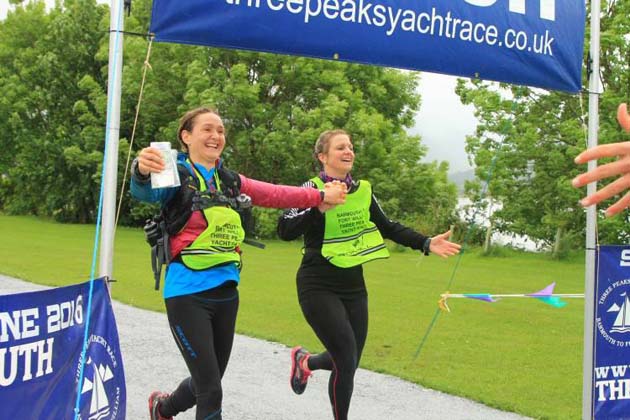
Jo and Lowri crossed the line, smiling and victorious. We had a group hug which ruined the cameraman’s finishing photos and cracked open the champagne. We had achieved what we’d turned up to do: won line honours, but not only that we had won the sailing part of the race overall on handicap and won leg 3 conclusively on sailing and running combined.
The runners from Pure Attitude put in a phenomenal run and managed to put their team 39 mins ahead of us on corrected sailing and running time combined to win the IRC trophy, for which we dropped into 2nd place.
The making of a team
When Elin suggested the Three Peaks Yacht Race to me earlier this year I jumped at the chance to sail with her and to race this epic course again. When she showed me her suggested line-up for the crew my stomach did flips. I knew we would be competitive.
The race has been an exceptional one and one of the best experiences of my sailing life. I have shared five days of hard physical and mental pressure with four of the most talented, strong and wonderful women I have ever met in my life.
As a team we were hand-picked by Elin, who knew us all individually, but we did not know each other. We all met for the first time less than two days before the start of the race – we had never practised sailing Nunatak together before the start gun went, Jo and Lowri first ran together the day before the race.

The sailing team
However, from the moment we met we were a team, we understood what was required of us as individuals and how best to work together. We supported and encouraged each other, were honest, took criticism, endured pain, sleep deprivation and physical discomfort because it was for the good of the team and all the while we laughed.
We were diligently and wonderfully supported by our shore team, Chris Frost and Mike and Pam Jacques, whose attention to detail did not waver and made transitions easy to handle, allowing the sailing team to eat and sleep knowing our runners were well supported on the mountains.
The fact that we are all women really should not and did not make a difference to our result. Every one of the crew of Team Aparito Digital Health is a serious athlete and when we line up on the start of any event we chose to take part in, it is on equal and respectful terms to everyone else there regardless of gender.
Endurance sport
When we came to the start of the Three Peaks Race we brought with us a wealth of experience from years of competing in multiple and diverse endurance events. Endurance sports require mental toughness as much as physical strength, and this is never more highlighted than in the field of ultra-marathon running and short-handed offshore racing.

We have taken on one of Britain’s toughest adventure races and proved that gender is not a factor in winning – you need to train hard, be well prepared, work as a team and never ever stop trying to do better.
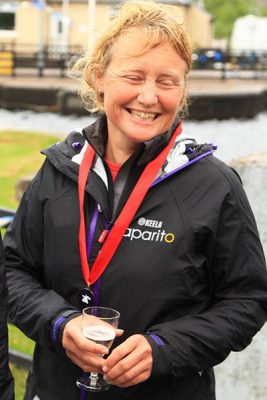 Of course I would like to say a massive thank you to all our supporters – Aparito Digital Health for their headline sponsorship, Sub Zero, Keela and Spindrift not only for providing fantastic kit for the race, but also for cheering us on all the way round. Primal Pantry and Mountain House also provided us with food.
Of course I would like to say a massive thank you to all our supporters – Aparito Digital Health for their headline sponsorship, Sub Zero, Keela and Spindrift not only for providing fantastic kit for the race, but also for cheering us on all the way round. Primal Pantry and Mountain House also provided us with food.
However the biggest thanks of all needs to go to Chris Frost who quite simply we would not have been able to do the race without. Chris allowed us to use his boat, prepared it for us, delivered it to the start and then followed us up the coast, never losing an opportunity to cheer us on from the shore or provide some sort of support. He and Mike even came out in a boat to shadow us up the shores of Jura.
The documentary following this year’s Three Peaks race, and featuring our team including on board footage will be available on SC4 in Welsh language as a three-part series in July and then a one-hour English language version will appear on Channel 4 later in the year
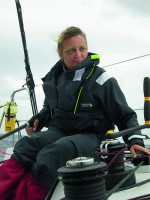
Single-handed ocean sailor Pip Hare has clocked up thousands of miles racing and cruising. Among her achievements are five solo transatlantics, including the OSTAR and two Mini Transat races. She also works full-time for the RNLI on sea safety and is Consulting Editor on Yachting World. See her gear test on weather routeing packages
See also Pip’s fascinating series on advanced sailing techniques: SAIL FASTER SAIL SAFER




